- Administrator
- Albums and Singles
 There are a number of great labels unearthing and breathing new life into forgotten treasures these days, but it is truly rare for anyone to match Dust-to-Digital when it comes to presentation and sheer comprehensiveness. Each major release feels like an event years in the making, certain to send at least one circle of obsessive music fans scavenging for additional extant releases from an eclectic array of previously unknown or obscure artists. This latest opus is an especially big hit with me, collecting a remastered trove of '50s East and Central African rumba recordings by South African/English musicologist Hugh Tracey. I had no doubt that these recordings would be unique and historically important, but I was legitimately blindsided by how incredibly fun these songs can be, often resembling a raucous, inebriated, and Latin-tinged street party where everyone knows all the words to every song and nearly everyone seems to have inexplicably brought along a kazoo.
There are a number of great labels unearthing and breathing new life into forgotten treasures these days, but it is truly rare for anyone to match Dust-to-Digital when it comes to presentation and sheer comprehensiveness. Each major release feels like an event years in the making, certain to send at least one circle of obsessive music fans scavenging for additional extant releases from an eclectic array of previously unknown or obscure artists. This latest opus is an especially big hit with me, collecting a remastered trove of '50s East and Central African rumba recordings by South African/English musicologist Hugh Tracey. I had no doubt that these recordings would be unique and historically important, but I was legitimately blindsided by how incredibly fun these songs can be, often resembling a raucous, inebriated, and Latin-tinged street party where everyone knows all the words to every song and nearly everyone seems to have inexplicably brought along a kazoo.
Few, if any, Westerners can claim to have done as much to bring African music to the world as Hugh Tracey, as he founded the International Library of African Music (ILAM) and made twelve separate treks into sub-Saharan Africa to collect instruments and record local musicians.Based on the recollections of his wife Peggy in the accompanying booklet, these trips were often far from pleasant, as the bad roads, rugged accommodations, car breakdowns, and illnesses inherent in such an endeavor made it quite hard to enlist a willing team.Also, people were not exactly clamoring to join the Traceys in the first place, as being so far ahead of the curve was a lonely life: having an intense passion for African music in the early '50s branded Hugh as a "crank" or a "dreamer" in most respectable circles.Amusingly, he also later took flak from the other side, as more "serious" ethnomusicologists took issue with some of his recording/editing preferences and his "staging" of traditional performances.According to Peggy, the "jackals" from the record company (Gallo) also pressured Tracey to focus on the more marketable "town" or popular music scenes, whereas he was much more interested in indigenous/traditional fare.It would probably break Hugh's heart a bit to see that so much "town" music wound up on this collection, but the jackals were surprisingly prescient, as that buoyant mélange of styles has aged remarkably well.I am completely out of my depth in trying to identify and follow the various improbable threads that found their way into these songs, but the most prominent influences to my ears tend to be Latin American and Caribbean in nature, though Hawaiian, Indian, and Arab influences are sneakily rampant as well.
Unsurprisingly, "town" music is quite a wide category in the context of this album, as Tracey found significant differences in styles as he and his crew traveled from region to region.That variety is best illustrated by the three versions of a single song entitled "Nimepata Mpenzi, Mtoto Mdogo, Mzuri, Simwachi (I Got a Young, Beautiful Girl that I Won't Leave)" recorded in Tanganyika and Malawi.Notably, it is one of the album's finest songs, yet each version takes a very different direction despite adhering to roughly the same melody and lyrics.In the Dar es Salaam version, the piece is a lurching, percussion-heavy sing-a-long with a drunken-sounding central theme played on violin and kazoo.In the Mawanza version (my favorite), the central melody is a gorgeously bittersweet swirl of flutes that harmonize and intertwine sensually.Elsewhere, in Malawi, the piece sounds like it was performed by a mandolin-wielding mariachi band.As if to pointedly emphasize the beguiling eclecticism of '50s African rumba still further, that triptych is followed by "Chineno," a wonderful piece by Dar es Salaam ballroom dance ensemble Merry Black Birds that resembles some sort of Thai or Arabic surf oddity that I would expect to encounter as the centerpiece of a Sublime Frequencies collection.My favorite piece on the album comes from the Congo, however, as Coast Social Orchestra's "Nali Kisafiri" is a radiant and rolling delight that sounds like a classic New Orleans jazz standard enlivened with a healthy dose of Cuban percussion and highlife rhythm.
Listen All Around is not exclusively populated by lively dance ensembles of varying competence and ramshackleness, however, as compiler Alex Perullo peppers the collection with entertaining oddities and delightfully rough-edged performances from Tracey's vast archive of ILAM recordings.Three such highlights are "Soko Olingi Na-Boma (If You Want to Kill Me)," "Kwa Jinsi Ninavyokupenda (How I Love You)," and "Mangwasi."The latter, a "passionately sung love song by a young Tukuyu musician" is among the rawest and most endearingly unhinged-sounding pieces on the album, as the melody is delivered in wonderfully motor-mouthed and hammy fashion over some three-chord jangling guitar, arguably anticipating punk by at least two decades."If You Want to Kill Me" is fun in a very different way, unfolding as a similarly rapid-fire vocal performance, but bolstered by plenty of backing refrains, lively and clattering hand percussion, and whistled melodies that seem to amusingly wander in and out of tune.Lastly, "How I Love You" is one of the album's true masterpieces, resembling a tipsy and lurching Latin brass band parade trailed by a wake of celebrants adding their own embellishments of honking kazoos and clinking bottles.That is actually just what the amateur-populated Dar es Salaam jazz band sounded like normally, which only earns them a deeper place in my heart.More than anyone else on the album, that band of spirited amateurs captures both what makes Listen All Around such a great collection and why Tracey was so captivated by the sounds of the region: even the least polished ensembles feel like a vibrantly alive and rhythmically inventive collection of cross-cultural magpies with a singular intuition for taking the best parts of literally anything they have heard and seamlessly making it their own.A lot of newly reissued ethnomusicological finds from the 1950s and earlier feel more like school than entertainment or pulsing, unfiltered life to me, but Listen All Around is a truly wonderful exception.
Samples can be found here.
Read More
- Administrator
- Albums and Singles
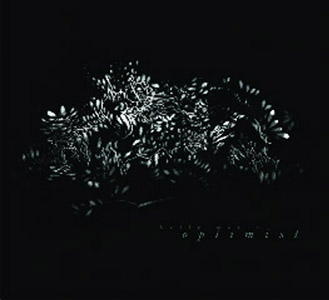 New York based composer and pianist Kelly Moran has been quickly developing a body of work that rich and complex with not just piano and electronics, but also her exceptional and nuanced approach to production and sound design as well. The instrumentation of Optimist may seem basic: all nine songs feature piano (prepared and unprepared) and some additional synthesizer and electronics, but the finished product has so much more depth than it would seem. It comes together as a fully realized, gorgeously diverse series of compositions.
New York based composer and pianist Kelly Moran has been quickly developing a body of work that rich and complex with not just piano and electronics, but also her exceptional and nuanced approach to production and sound design as well. The instrumentation of Optimist may seem basic: all nine songs feature piano (prepared and unprepared) and some additional synthesizer and electronics, but the finished product has so much more depth than it would seem. It comes together as a fully realized, gorgeously diverse series of compositions.
A number of these songs feature Moran leading the traditional sounding piano to the forefront, which is no surprise.The opening "Optimist" features the mostly pure piano sound, seemingly presented in interlocking loops, with additionally treated passages and plucked strings rounding out the piece into an understated, yet dynamic structure.Her playing on "Nyght Spel" is a bit more deliberate:harder, hammered sounding piano notes command attention, although presented in an overall pleasant sounding melodic framework, as additional electronics and synths flesh out the mix.
During other moments, the piano is there, but utilized less in its conventional sound.During "Strangers are Easy to Look at, Loved Ones are Museums of Brutality" (the perfect song title for the current holiday season), it is sparingly used, with infrequent notes dowsed in echo and reverb.Synthesizers and ebows are used to construct a glistening, icy wind that drifts through the mix.On "Let's Dance", Moran takes the sound of her piano into more lo-fi spaces; a hollow, thin sound that is still the instrument in question, but with a unique edge on it overall.More synthesizer layers are blended in to fill out the performance quite beautifully.
The sound is even more out there when "Glacial" comes around.Plucked strings instead take on the sound of tonal, gorgeous bells that chime out, and her ebow and synthesizer additions add a slightly grimy, almost distorted guitar-like patina to the otherwise pristine sounds.Moran employs the same tools to "Dream Pauline" with notably different results.In this case, there is a dynamic, up-tempo flow to the composition, and besides the conventional sounding piano she also blends in lush, droning tones and an almost harpsichord-like sound from her treated piano.The final product is a faster, more rapidly flowing piece that wonderfully contrasts the more pensive, delicate moments of the record.
Like her other albums, Optimist is solely the work of Kelly Moran:composition, performance, recording, and production.While obviously demonstrating immense talent and skill on her part, it also has a positive impact when it comes to the final product.These compositions clearly demonstrate the singular focus she has on her art, and also what can be achieved when an artist is able to exert complete control.In some scenarios this could lead to a bloated, self-indulgent piece of music, but Optimist is anything but.Instead it is diverse, varied album of beautiful sounds that demonstrates a multitude of dynamics, but all unquestioningly linked by Moran’s hand.
Read More
- Administrator
- Albums and Singles
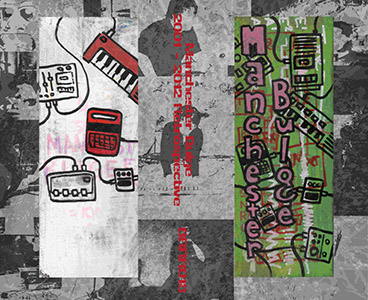 It seems like any American city (or even large-ish town) has at least one local noise band. Perhaps it is the ubiquity of the Internet or a handful of Wolf Eyes and Merzbow albums that received some significant hype and distribution, but what was once a style that was baffling to most is on par with punk or hardcore as far as local representation goes. Manchester Bulge, hailing from Fargo, North Dakota, preceded this American noise band explosion (or sloppy outburst, depending on perspective) though, dating back to 2001. This collections captures a band at the forefront of what somehow managed to become a scene and makes for an excellent window into one town’s premiere noise project.
It seems like any American city (or even large-ish town) has at least one local noise band. Perhaps it is the ubiquity of the Internet or a handful of Wolf Eyes and Merzbow albums that received some significant hype and distribution, but what was once a style that was baffling to most is on par with punk or hardcore as far as local representation goes. Manchester Bulge, hailing from Fargo, North Dakota, preceded this American noise band explosion (or sloppy outburst, depending on perspective) though, dating back to 2001. This collections captures a band at the forefront of what somehow managed to become a scene and makes for an excellent window into one town’s premiere noise project.
Admittedly, for something that covers a span of just over a decade, the sense of organization or structure to 2001-2012 Retrospective is confounding at best.There is no clear timeline of when these various pieces were recorded, and the titles themselves are ambiguous to say the least. The small included booklet does give some insight into the project overall and features some nice photography, but it is best to take things in at face value rather than look for a deeper underlying concept.
Most of the material spread across these three tapes was captured live, and that definitely shows.Dying tape motors and wobbling electronics give "Tromittar" a fun, haunted house vibe that is furthered by an indistinct far off clatter and the occasional monstrous growl.Everything stays mired in an appropriately low fidelity murk and, even with some melodies rising up near the end, it continues to sound more than just a bit off."MB Track 1 PT2" continues with the ghostly feel, with clanging synth stabs cutting through bent synth string passages.
Other facets of Manchester Bulge's sound are a bit looser and less bleak in nature.Sputtering sounds, toy piano, and bursting electronics define most of "Barn" in a simple, yet pleasant outburst of noise."10/8 MB12" is another shambling mélange of sound:stuttering noises and mangled computer data tapes set the stage for something that sounds like a keyboard found in the forgotten backroom of a Goodwill warehouse, covered in cobwebs and spider eggs,but somehow manages to still work and therefore is a viable instrument for Manchester Bulge.
The third tape in this set is the one that comes across as the strongest and most focused, however.Toy organ tones and jackhammer like electronics end up making "Upfront" almost melodic in some sort of twisted way, with a nice psychedelic edge to it.Both "Meth Lab" and "MB2" feature Manchester Bulge working with tapes, via erratic sputters, backward noises, and wobbling pitches and tones.The latter also excels with a bit of banging metal and shimmering, nervous electronics at its end.The flip side of the tape excels with "MB Live Raven", with its opening of a noise standby:the buzz and feedback of what sounds like a bass amp.Even with the harsher sounds used, there is a nice sense of space throughout, allowing all of the elements to shine, even if they are buzzing, brittle electronics that sound about to fail at any time.It builds to an almost prog rock climax of harshness and depth before collapsing wonderfully.
I have always been a fan of these sorts of releases.Having never been to North Dakota and, if I had, I would likely not be going to some small noise house show; this collection gives me an almost ethnographic overview of such a scene.Manchester Bulge's is Fargo's longest running noise project and, while different than ones I have encountered, it features that same universal sense of experimentation and actual fun that can be had within such a band.As with any band doing this type of release, there are a handful of less engaging or meandering moments here and there, but, warts and all, it is a fascinating snapshot into the career of a local noise band.
Samples can be found here
Read More
- Administrator
- Albums and Singles

Artist: Hirsute Pursuit feat. Boyd Rice
Title: Boyd Keeps Swinging
Catalogue No: CSR157EP
Barcode: 8 2356650662 1
Format: 12" in full colour glossy sleeve
Genre: Gay / Industrial / Techno / Electronica
Shipping: Now
Man To Man Electronic Sex Music. This 12” vinyl features 6 remixes of the David Bowie song, ‘Boys Keep Swinging’, with guest vocalist Boyd Rice (NON), who also stars in the music video.
A veritable “who’s who” of musicians / remixers give the track a dancefloor makeover, from grinding Industrial to hard techno: ALAN GREGORIE (Depeche Mode, The Cure, Cyndi Lauper), DEREK RUSH (Dream Into Dust, Compactor, A Murder Of Angels), BRYIN DALL (Thee Majesty, 4th Sign of the Apocalypse), RAE DILEO (Henry Rollins, Filter), MC Spacebar (Hirsute Pursuit, Loretta’s Doll), EDLEY O’DOWD (PTV3, The Toilet Boys, Tony Conrad).
Limited edition vinyl with provocative artwork by Syluss Fortay.
Tracks: A1. Boys Keep Swinging (Los Ninos De Amor Mix) - Alan Gregorie | A2. Boys Keep Swinging (Boys Club Mix) - Derek Rush | A3. Boys Keep Swinging (Uniform Mix Mix) - Bryin Dall | B1. Boys Keep Swinging (Blade Kraft Mix) - Rae Dileo | B2. Boys Keep Swinging (A Little Bit Dirty Mix) - MC Spacebar | B3. Boys Keep Swinging (Boodle Boy Mix) - Bryin Dall & Edley ODowd
Read More
- Administrator
- Albums and Singles
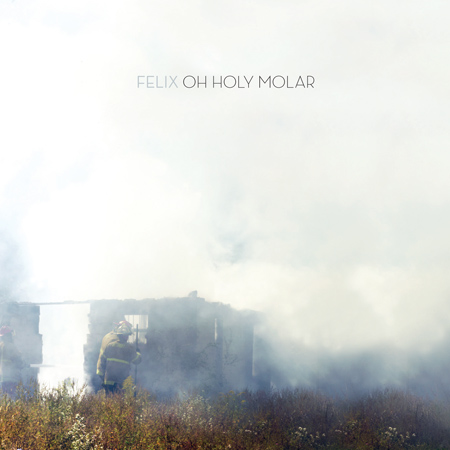 Felix seem to approach the art of songwriting with an oblique playfulness similar to such groups as Slapp Happy or Hugo Largo, albeit with darker results. Minimal accompaniment frames Lucinda Chua singing meticulous and poetic lyrics, using everyday expressions and bizarre thoughts in a conversational style, touching on magical realism without sounding twee or trite. Oh Holy Molar is a convincing existential internal dialogue, by turns bleak, funny, honest, inspiring, sad, and wry.
Felix seem to approach the art of songwriting with an oblique playfulness similar to such groups as Slapp Happy or Hugo Largo, albeit with darker results. Minimal accompaniment frames Lucinda Chua singing meticulous and poetic lyrics, using everyday expressions and bizarre thoughts in a conversational style, touching on magical realism without sounding twee or trite. Oh Holy Molar is a convincing existential internal dialogue, by turns bleak, funny, honest, inspiring, sad, and wry.
This is the group's second album, recorded in an old cinema in England. Lyrics are the primary focus and these are both crystal clear and slicked with ambiguity. "The Bells," for example, mocks people who, to hear them talk, know everything, buy houses at the right price at the right time, and will deserve to be buried with churches ringing out in appreciation of them, or to echo our joy at their demise! Guitarist Chris Summerlin and drummer Neil Turpin punctuate and underscore Chua's piano and vocals, to superb effect on "Hate Song," with its lacerating lines, "This is what you get/When you take from your friends/And you make out like you didn't/And you never give anything back/No love."
"Sunday Night" utilizes two piano notes and the merest sliver of guitar to create a lovely atmosphere as Chua weaves suspicious questions with the suggestion of secrets. Most of the pieces are led by piano, but the revenge song "Rites" rests on Summerlin's languid but crunchy guitar. After a few listens I don't like all the songs, or rather would prefer to listen to just three or four at a time, treating Oh Holy Molar as if it were a journal found in the underwear drawer of a former partner, and only risking a few pages here and there.
"Oh Thee 73" is an anthem of sorts, with the line, "Friday night is the worst night to be alive/Would you help me to get out of the firing line," at its core. Onto this image Chua seems to project deft observations hinting at dread, maybe of the horror of drunken invitations, inclusion, meat market discos, and missed friends, when sometimes only dry humor and musical cynicism can buffer a sensitive individual from the whole landscape of up-close angst and collective alienation of a bad Friday night out, or in.
After a fair amount of drama, the final piece "Little Biscuit," may allude to the accepted notion, in England at least, that a cup of tea makes everything better. This cherishing of the mundane and ordinary ritual has a comforting zen truth which transcends mockery. We English would never have a biscuit (cookie) without a cup of tea, and tea is some of our existential glue in times of awkwardness, bereavement, boredom, despair, happiness, heartbreak, love, retreat, and war. Rumor has it that after this record was finished Felix discovered an old dental laboratory under the cinema space. Whatever the truth of that story, the album title and mentions of teeth worn as a necklace or falling out in a dream add to the overall air of superstition and ancient fears of everything from rejection, impotence, putting faith in the wrong person, impending sickness, and death. Things with which tea can always help.
Read More
- Administrator
- Albums and Singles
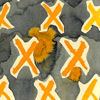 The Fukushima Daiichi nuclear disaster and the Tohoku earthquake and tsunami that set it in motion are more than a year and half old this month. Ongoing cleanup efforts, which include removing contaminated debris and preventing further radioactive water from seeping into the ocean, will likely cost $15 billion over the next 30 years. As Otomo Yoshihide explained in his April, 2011 lecture, the residents of Fukushima face a difficult future, one made darker by the psychological and cultural impact the disaster has had. In response to that lecture, Presqu'île Records assembled this compilation, featuring superb contributions from the likes of John Tilbury, Greg Kelley, Michael Pisaro, Chris Abrahams, and Annette Krebs. Besides answering Otomo’s plea for a cultural response to the disaster, all funds raised from the sale of this 2CD set go to Japanese non-profit organizations.
The Fukushima Daiichi nuclear disaster and the Tohoku earthquake and tsunami that set it in motion are more than a year and half old this month. Ongoing cleanup efforts, which include removing contaminated debris and preventing further radioactive water from seeping into the ocean, will likely cost $15 billion over the next 30 years. As Otomo Yoshihide explained in his April, 2011 lecture, the residents of Fukushima face a difficult future, one made darker by the psychological and cultural impact the disaster has had. In response to that lecture, Presqu'île Records assembled this compilation, featuring superb contributions from the likes of John Tilbury, Greg Kelley, Michael Pisaro, Chris Abrahams, and Annette Krebs. Besides answering Otomo’s plea for a cultural response to the disaster, all funds raised from the sale of this 2CD set go to Japanese non-profit organizations.
Otomo Yoshihide’s April 28, 2011 lecture at the Tokyo University of the Arts is titled "The Role of Culture: After the Earthquake and Man-Made Disasters in Fukushima." Delivered just one month after the Fukushima meltdown, it recounts and explains the fears and dejection such a disaster can cause, among them concerns about the presence of radioactive material found in Tokyo’s drinking water. But, much of the lecture focuses on the psychological and cultural impact felt by the people of the Fukushima prefecture. How, he asks, should musicians and artists respond to the disaster? What, if anything, can they do to help energize Fukushima so that the prefecture's name doesn’t become a pejorative term (the way that Chernobyl did) and suffer the pangs of infamy? One answer, according to Otomo, is to find positive cultural associations for Fukushima. That’s where Presqu'île Records comes in.
Comprised of ten recordings spread across two CDs, Fukushima! lends its musical explorations to the prefecture’s name and, one hopes, responds effectively to Otomo’s call for positive associations with the region. It’s also a fund-raising effort, with all the proceeds going to non-profits in Japan. The featured artists come from all over the world: from California to Germany, the UK, and South Korea. But not even a single artist is from Fukushima, or Japan, which might seem strange except that Otomo’s lecture is partially motivated by how he hopes the world will perceive Fukushima in the future. This album, then, is a sign of solidarity from outside Japan.
Disc one begins with a monster 34 minute contribution from AMM’s John Tilbury. His performance of Dave Smith’s "Al contrario" is the longest performance on the CD by over ten minutes, and a curious choice for first song. Tilbury is undoubtedly one of the most talented pianists in the world, but Dave Smith’s composition, which feels clunky and a little straightforward compared to the other songs on this disc, does little to highlight his talents. Its repetitive structure, on the other hand, has a lulling effect that makes its duration less of a problem than it might otherwise be. It’s followed by two absolutely killer performances, and two of my favorites from the entire compilation: one by Magda Mayas, playing inside piano, and one by the quartet of Choi Joonyong, Joe Foster (of English, with Bonnie Jones), Hong Chulki, and Jin Sangtae, who all currently live in South Korea if I’m not mistaken. I’d not heard Magda play before hearing her contribution, "Foreign Grey," but now I’m determined to find more. The tones, colors, textures, and variety of sounds she pulls from her piano are phenomenal, and the attention she gives to the volume and density of her piece makes it all the more hypnotizing. The South Korean quartet provides "From Dotolim," a tense and delicate piece that takes textures and material noises as its primary elements. It’s a varied, somewhat subdued performance that emphasizes space and slow development, but its unpredictably and playfulness have me wishing it would go on longer.
Fukushima!’s second monster contribution (this one 21 minutes long) comes from Greg Stuart, who performs Michael Pisaro’s "The Bell Maker" from Four Pieces for Recorded Percussion (Il faut attendre). Mysteriously dedicated to both Andrei Tarkovsky and Julia Holter, this piece, composed of numerous, tiny bell-like sounds, flickers as though it were fixed in space, not moving so much as hovering. I enjoy it, but find myself returning more to Mark Wastell and Jonathan McHugh’s "Eventide." It’s huge low-end and hum and oddly lulling rhythm get my attention every time. There’s something vaguely machine-like and lonely about it, and whether by accident or design, it gets me thinking about the power plant and how it must loom over the area. Annette Krebs, Chris Abrahams, Burkhard Beins, and Greg Kelley all contribute solid performances, but it’s the Australian/Norwegian trio of Mural that sticks out in my mind the most. "Fukushima for the Time Being" is unlike anything else on the compilation, actually. It features Japanese flute, gongs, bells, possibly motorized strings and bowed metal, plucked strings, and numerous other sound sources I can’t readily identify blended into a ritualized improvisation with a little theatrical flair. Thanks to the melody provided by the flute, and some regularly recurring patterns, I’m convinced that this piece is a bit more composed than the others, so it sticks out among the other pieces and breaks the second disc's flow up a little bit. I think it’s a great change of pace, though, and a definite highlight.
More than just a compilation for a good cause, Fukushima! is an excellent collection filled with beautiful music. The variety of talents present almost guarantees that listeners will be introduced something new, too, which is one of the best things any compilation can do.
samples:
- Choi Joonyong, Joe Foster, Hong Chulki & Jin Sangtae, "From Dotolim"
- Annette Krebs & Chris Abrahams, "Duo"
- Mural, "Fukushima for the Time Being"
 
Read More
- Administrator
- Albums and Singles
 An established drummer and improviser, Rosaly takes this background into a different direction, dissecting and reassembling his own improvised recordings into a structured, though intentionally chaotic composition. While the drums make for the most identifiable sound, the non-percussive elements are just as essential, resulting in an album that occasionally calls to mind the best moments Organum, but stands firmly on its own.
An established drummer and improviser, Rosaly takes this background into a different direction, dissecting and reassembling his own improvised recordings into a structured, though intentionally chaotic composition. While the drums make for the most identifiable sound, the non-percussive elements are just as essential, resulting in an album that occasionally calls to mind the best moments Organum, but stands firmly on its own.
The first side of the LP leads off aggressively, with guttural, overdriven bass frequencies and rhythmic undulations that eventually make room for the drums.For the most part, Rosaly's playing is metered and sparse, but provides an effective drive to the piece, made all the more effective by the occasional percussive outburst.This combination of steady, metronomic playing and pseudo-blast beats continues, enshrouded by the overdriven, but tasteful layers of noise, before throwing in some abrasively sharp metal crashes.
Dropping to silence, it slowly comes back together via effected buzzes and high-pitched drones that wobble in and out of audible frequencies.It then segues into full on gamelan percussion, pure and resonant, to push the sound into a different place entirely.It is on a fragmented, sputtering note that the first half ends, letting bits of gamelan and metallic chimes drift off in entropy.
The flip side immediately comes across as darker and more sinister, with treated feedback and creaking metal setting the stage.Bent percussion and demonic metal scrapes lurk, channeling seriously evil images without becoming overly aggressive.Eventually the piece falls apart again to a more electronic sounding passage before closing on full bore percussive polyrhythms, again bringing a malignant darkness.
Centering and Displacement was originally conceived as a six-channel installation by the artist, although Rosaly considers this stereo mix to be the definitive one.Admittedly, I would love the opportunity to hear the full multi-channel mix, since I am curious how both the more frenzied and contrasting sparse moments would be spread across that spectrum.However, this LP stands strongly on its own, and does an excellent job at balancing the raw, chaotic moments with the calmer, pensive ones.It does seem to be a contradiction to the idea of improvisation by using it as a jump-off point for tightly organized composition, but I can not argue with the results.
samples:
 
Read More
- Administrator
- Albums and Singles
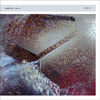 As half of the duo Solo Andata, Kane Ikin works heavily with treated and processed field recordings, shaping them into complex, sometimes shadowy organic compositions. On this solo outing he works less with nature, but uses practically everything else (synthesizers, drum machines, rotting vinyl, etc) to create an album of similar complexity, albeit a darker, more isolated sensibility.
As half of the duo Solo Andata, Kane Ikin works heavily with treated and processed field recordings, shaping them into complex, sometimes shadowy organic compositions. On this solo outing he works less with nature, but uses practically everything else (synthesizers, drum machines, rotting vinyl, etc) to create an album of similar complexity, albeit a darker, more isolated sensibility.
As an admitted sucker for both textural vinyl surface noise and vintage drum machines, I was instantly enamored with the likes of "Europa" and "Hyperion", both of which focus heavily on the decaying static of old vinyl and erratic, shambling synthetic rhythms.Although the machines appear throughout, Ikin opts to make it less about a programmed rhythm, and more about using the individual beats and hits as the focus.While the former opens the album in a dramatic fashion, the latter closes it in a sparse, skeletal coda.
The album seems to be almost split, with the first half consisting of more complex, deep compositions, and the remainder working more within spacious, arid territories."Slow Waves," for examples, obscures a melodic thrust that sounds far off in the distance with undulating bass drone and surface noise, while the loop-heavy "Rhea" slowly piles layers on into a static laden, almost harsh piece.This is very much contrasted by the fragments of music and heavily processed rhythm of "Black Sands," and the distorted beats and gentle white noise puffs of "Compression Waves."While the album and song titles conjure a distinct cosmic feeling, it is only on a few pieces such as "Oberon" where it seems an obvious theme.Distant, radar like pulses guide much of the song, even into its more disjointed, dissonant ending.
At 16 pieces, there are a lot of ideas crammed into Sublunar, but never does it feel incoherent or messy:they all have a common murky sensibility to them, a sort of post-rock tinged take on ambient music and industrial drone.The worst part is that a few of the miniature pieces, such as the stuttering rhythms and what may be guitar of "Titan" and the fragmented beats of "An Infinite Moment" are simply too brief, with the former clocking in at under a minute.I personally would have enjoyed hearing these sounds and styles expanded upon, but I would not want that in lieu of any material already a part of this album.While I have definitely enjoyed Ikin’s work with Solo Andata, I think I would be just as eager to hear a follow up to this one.
samples:
 
Read More
- Administrator
- Albums and Singles
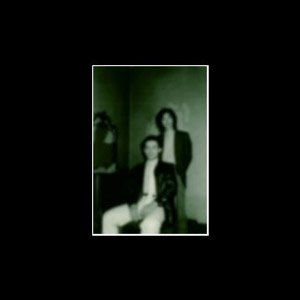 Masami Akita and Maurizio Bianchi are without question amongst the pioneers of harsh, abrasive electronic music. Both of their careers began quite prolifically around the same time, and since Bianchi's return in the late 1990s have continued as such, with both producing a massive number of albums each year. These two albums act nicely as reference points on their long careers, with the 10" capturing pieces each submitted for the Mail Music Project compilation, here appearing unedited for the first time, and the LP being a recent collaborative work that stands amongst both artists' best material as of late.
Masami Akita and Maurizio Bianchi are without question amongst the pioneers of harsh, abrasive electronic music. Both of their careers began quite prolifically around the same time, and since Bianchi's return in the late 1990s have continued as such, with both producing a massive number of albums each year. These two albums act nicely as reference points on their long careers, with the 10" capturing pieces each submitted for the Mail Music Project compilation, here appearing unedited for the first time, and the LP being a recent collaborative work that stands amongst both artists' best material as of late.
The material on the 10" was recorded contemporaneously, but independently from one another for the aforementioned 1983 compilation that presented only a minute of each work.Bianchi's contribution, "Amniocentesi," is pure 1980s M.B.: all slow decrepit electronics and depressive atmospheres.The morose, damaged synths are occasionally met with a stammering, fragmented drum machine likely from a broken down organ, with everything staying firmly rooted in Bianchi's grey and cheerless ambience.
The Merzbow piece, "Envoise 30 05 1982," sits nicely with his early 1980s discography, before he became overly focused on piercing harsh noise blasts and instead dabbled in tape loops and found sounds.Phasing distortion overshadows slowed down tape collages, with the occasional burst of harsh noise that makes for a strong rhythmic accent.With some fuzzy textures and turntable scratch skittering, it is pure old school Akita, and easily my favorite era of his career.
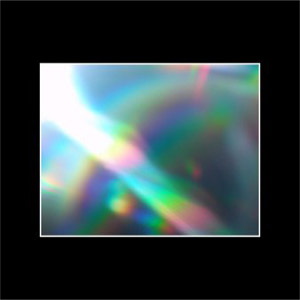
The material on Merzbow Meets M.B. is recent work from both acts as a true collaboration, and the bonus included 7" makes for a nice split release to compare to the 10" as far as the individual artists' work goes."Dissonant Abstraction" initially is all roaring, cavernous Merzbow noise, but kept restrained and under control.Low register swells and patterns make for an ersatz rhythm, with haunting passages of synthesizer clearly marking Bianchi's contributions.His work here has shades of his more recent new age material, but it works, balancing out the harsher end of Akita’s harsh noise.In some ways it sounds like each artist’s solo work mixed together, and it is rather effective.
The other half, "Surreal Distortions," is overall more in the noise spectrum of things, with muffled, bassy noises and thin analog electronics.There is not the same hints at melody as on the other side, and instead focuses on harsher textures.Bent oscillators and electronic chirps mark this a clearly analog piece, and with the occasional use of phasing and flanging it calls to mind some of CCCC and Astro's best work.Here it feels more like a collaboration between the two, with Akita’s use of chaotic mixing and Bianchi’s use of synthesizer sounds.
The 7" single included with the LP features each artist contributing their own recent solo works as well, and while both are excellent, neither are surprising.Merzbow's "Fragment B" is all scraping metal and bleeping electronics, so in some regards is a throwback to his early 1990s junk noise sound without the overly loud electronics.An occasional rhythm sneaks in here and there, but for the most part it is pure chaos.Bianchi's "28th Flux" has the bleakness of his early works, but a more modern, higher fidelity sheen covering the pained electronics and darkness.
As both artists are ridiculously prolific, and I personally have a fondness for their earliest work in both cases, I tend to only occasionally dabble in either of their new releases.In this case, the recent collaboration work is exactly what I hoped it would be, mixing the best sounds of both artists together splendidly.Coupled with the vintage material on the 10", and it makes for a pair of releases that demonstrates the best facets of these two long respected artists.
samples:
 
Read More
- Administrator
- Albums and Singles
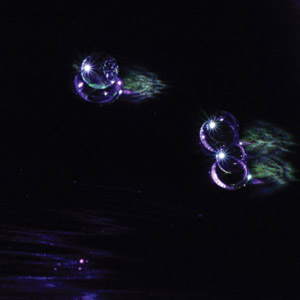 An audio-visual collaboration featuring Evelina Domnitch, Francisco López, COH, and Asmus Tietchens (amongst others), Liquifed Sky is truly a synthesis of audio and visual, emphasizing the indisputably organic connection between fluid and light, as well as the physical effect of sound waves upon both. It might not be the most convenient release, being a data DVD, but is well worth the effort.
An audio-visual collaboration featuring Evelina Domnitch, Francisco López, COH, and Asmus Tietchens (amongst others), Liquifed Sky is truly a synthesis of audio and visual, emphasizing the indisputably organic connection between fluid and light, as well as the physical effect of sound waves upon both. It might not be the most convenient release, being a data DVD, but is well worth the effort.
Half of this release is made up of a two part visual piece titled "Mucilaginous Omniverse" by Domnitch and Dmitry Gelfand, the first half scored by COH and the second by Domnitch and Gelfand.The visual component of both is a series of colorized video recordings of drops of silicone oil being propelled by the sound waves of the audio accompaniment, with the droplets merging together into natural geometric shapes and then dissipating.For the first part, COH's shimmering noise and radio-like static create a sense of cohesion as synth bell tones and fluttering electronics keep things flowing.It may seem abstract at first, but there is a surprising amount of structure and organization to it.The audio portion contributed by Domnitch and Gelfand on the second half has less musicality to it and instead a cold, clinical sound that works quite well on its own.Oscillating between delicate microsounds and deep, heavy passages of menacing electronics, the piece closes on a rather soft note.
"Hydro Acoustic Study," visualized by Paul Prudence and scored by Francisco López is a different experience entirely.The video component is heavily digital, consisting of patterns and shapes modeled to match the properties of water and shaped by the sound that propels it.Using generative strategies to visually animate, López' sound is at times more aggressive and forward than I usually expect from him.His penchant for quiet, near silent moments are interrupted violently, eventually locking into a mechanical rhythm that causes digital interference in the visual proportion.
Finally, Domnitch and Gelfand present "Memory Vapor," made up of a cloud chamber and particle accelerator illuminated by a white laser that becomes a spiraling, neon tinted prism of particulate matter.The audio portion by Asmus Tietchens is shrill and somewhat sparse in nature compared to his other work, but is completely effective, with its dirty, grimy hue acting as a perfect counterpoint to the fragmented visuals.
Authored as a data DVD, rather than a traditional video disc, the highest resolution playback of these videos (in 1080p) is allowed.However, that means that it is unlikely to play in most standard DVD players, and given the significant bitrate of each video, streaming it off the disc is not the smoothest experience.For that reason it is best copied to a hard disk before playing (each video is between 1 and 2.5 gb), and thus it is not necessarily the easiest thing to just throw on.In some ways it makes for the perfect antithesis of the prevailing lower fidelity, digital download culture that has gripped most forms of music.I watched it via a PC connected to my TV and audio receiver, but I would have preferred if it had been presented as a BluRay disc instead for the sake of convenience.However it is presented, both the visual and audio portions match each other perfectly, with neither overshadowing the other in significance, resulting in an experience that is worth the effort.
Read More
- Administrator
- Albums and Singles
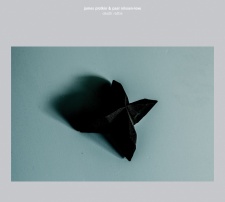 Amongst fans of dark, heavy music, James Plotkin is a name synonymous with work that defies categorization or genre boundaries in a slew of projects too numerous to list. Lesser known, at least perhaps in the USA, is drummer Paal Nilssen-Love, who may be working from a free jazz template but produces music that is similarly impossible to categorize. The two meet here for the first time on Death Rattle, the result of a four-hour improvisation recorded last year, and the result is as blistering and intense as expected.
Amongst fans of dark, heavy music, James Plotkin is a name synonymous with work that defies categorization or genre boundaries in a slew of projects too numerous to list. Lesser known, at least perhaps in the USA, is drummer Paal Nilssen-Love, who may be working from a free jazz template but produces music that is similarly impossible to categorize. The two meet here for the first time on Death Rattle, the result of a four-hour improvisation recorded last year, and the result is as blistering and intense as expected.
The four pieces that make up the album work with only Plotkin's guitar and Nilssen-Love's drumming, but the result is anything but simplistic.The emphasis is on the guitar on "The Skin, The Color," wavering between chugging rhythm and kinetic free improvisation.All the while, Nilssen-Love's manic drumming lurks in the background; his flailing, hyperactive playing acts less as the rhythm and more of a lead instrument.
The line between hard-edged metal structures and explosive free jazz improvisation is straddled on "Cock Circus" the clearest.Right from the beginning with the more riff-oriented playing jumping in and out of grinding noise, and by the same token, the drums balance between sharp, aggressive patterns and explosive, loose improvisations.Just when it sounds like it is getting into indulgent noodling it locks back into a rigid groove to mix things up.
Less overt, but also vacillating between order and chaos is the title piece, which features inhuman sounding Plotkin squall that mimics the title of the song perfectly, as Nilssen-Love's snare rushes serve as a punctuation to the grotesque guitar."Primateria" has the most erratic feel of the four songs on here, with tightly clipped guitars and percussive accents slowly building up and collapsing.The whole time it sounds like it is about to fall apart into an unstructured mess but it never happens.Considering this was the last material recorded in that four-hour session, this is probably less of a conceptual decision and more just physical fatigue setting in.
Death Rattle is not a surprising record by any means, and I mean that as the utmost compliment.Anything I have heard either Plotkin or Nilssen-Love involved in has defied any sort of easy description, but is always riddled with strength and innovation.Even here stripped down to two core instruments, that intensity is no less present, and makes for another high water mark in both artists' impressive discographies.
samples:
 
Read More


